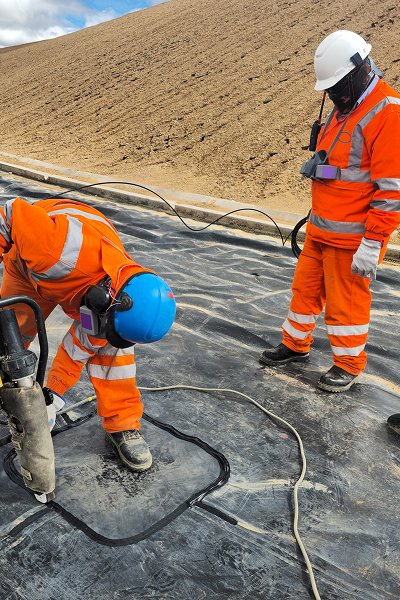Geogrid Material Characteristics and Functions
Features: High strength in one direction (usually longitudinal).
Application: Used for reinforcement in the direction of the main stress, such as raising slopes, filling behind retaining walls, etc.

Features: High tensile strength in both longitudinal and transverse directions.
Application: Used for plane reinforcement, suitable for structural layers subjected to complex stress in highway and railway subgrades.

Triaxial or Multiaxial Geogrid
Features: Using a triangular or honeycomb structure, it can more evenly distribute multi-directional loads.
Application: More suitable for complex stress environments, such as multi-directional wind loads and uneven settlement areas in deserts.


Geogrid Characteristics and Performance Parameters
The core structure of a geogrid is a grid of open cells. Key performance parameters include:
Tensile strength (kN/m): reflects the grid's ability to resist tensile failure.
Elongation (%): influences the deformation coordination between the grid and the soil.
Creep performance: affects its long-term load-bearing stability.
Mesh size and shape: directly determine its sand retention and embedding properties with filler materials.
Mechanism of Action for Resisting Soil Loss
Interlocking Effect
When geogrids are laid in loose sand, their mesh structure "locks" sand particles within the grid, reducing particle movement and enhancing the foundation's shear resistance. This interlocking effect is particularly suitable for wind-blown sand or water-laden loose sand.
Stress Diffusion
By dispersing concentrated stress from vehicle or structural loads, geogrids distribute the load over a wider area, reducing stress per unit area, minimizing settlement and localized shear failure, and reducing the risk of soil loss.
Reinforcement Constraint
The grids constrain soil deformation through tension, preventing lateral flow or shear failure, thereby enhancing the stability and bearing capacity of the entire roadbed structure.
Erosion Control
The grid structure covers the ground surface, effectively blocking direct wind erosion of surface sand particles. Combined with gravel or vegetation, it forms a highly effective composite windbreak.
Advantages of geogrids in desert environments
UV resistance: In high-radiation desert environments, HDPE or UV-resistant geogrids maintain stable performance over time.
Corrosion resistance: Dry, saline-alkali soils are common in deserts, and the chemical inertness of geogrids prevents them from reacting with soil components.
Resistant to temperature swings and wet-dry cycles: Traditional structural layers are prone to cracking due to the dramatic temperature swings between day and night, while geogrids offer excellent flexibility and adaptability.
Easy installation: Lightweight and easy to transport, geogrids do not require large construction equipment, making them particularly suitable for construction in dune terrain or remote locations.
Challenges of road construction in desert areas
Loose geological structure and low foundation bearing capacity
Loose particles: The sand grains lack bonding, remaining free and easily disturbed or moved.
Low bearing capacity: The foundation soil has low shear strength and high compressibility, making it unable to withstand concentrated loads.
Uneven surface: Frequent sand movement causes uneven subsidence and localized collapse of the roadbed.
Severe wind erosion easily erodes the surface sand.
Strong wind transport: When wind speeds exceed a certain threshold, sand is swept up and transported over long distances, forming mobile sand dunes.
Sand is hollowed out of the roadbed: Wind erosion destabilizes the surface structure and leads to frequent slope collapses.
Wind-blown sand silt deposits on the road surface: This causes long-term burial of the road surface, disrupting traffic and increasing cleanup and maintenance costs.
Extreme climatic conditions can easily age and deform materials.
Large temperature swings between day and night: In desert areas, the temperature can fluctuate by over 30°C, causing thermal expansion and contraction in structures, leading to cracks.
Strong ultraviolet rays: Long-term exposure can cause material degradation and weakening.
Frequent wet-dry cycles: This can cause fatigue damage to traditional materials such as asphalt and cement.
High salinity and alkaline soils: This can corrode metal components and certain inorganic materials, shortening their lifespan.
Saudi Arabia Highway Reconstruction Project
Project Overview:
The road was repeatedly buried by sand during the windy and sandy season, resulting in high maintenance frequency and low traffic efficiency.
Design Concept:
PET bidirectional geogrids were combined with a local gravel layer to form an interlocking cushion.
Effectiveness Evaluation:
After the grid installation, the impact of wind erosion was significantly reduced, and no structural settlement was observed in some sections of the road within five years.
Vegetation on both sides of the road has recovered well, providing additional wind and sand control.
The PET material used has excellent creep properties, ensuring long-term load stability.



